Tool Test: Cordless Track Saws
The best tool for straight, splinter-free cuts is made even better without a cord.
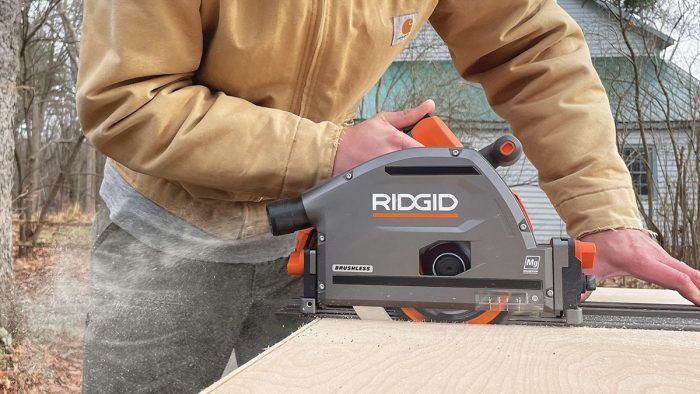
Track saws are game-changing tools, and the cordless models only up this convenience, according to builder Jeremy Kassel. In this tool test, he finds the best cordless track saws by comparing eight cordless models, testing their cut quality and power, their smoothness and accuracy when beveling, and their ability to create long, tapered shims.
Why Your Track Saw Matters
The uninitiated might argue that a straightedge or shooting board paired with an ordinary circular saw does the same thing as a track saw. But anyone familiar with this game-changing tool understands that the secret is the aluminum track. It’s light and laser-straight, and it has a replaceable splinter guard that indicates the exact location of the cutline for quick setups. The splinter guard’s plastic or rubber edge almost touches the blade, so the blade cuts through the wood fibers instead of lifting them, creating smooth cuts even with splintery material like lauan and veneer plywood. The tracks, also called guide rails, come in lengths from under 3 ft. to more than 16 ft. long. They have anti-slip strips glued to the bottom that eliminate the need for clamping the tracks to all but the slipperiest or narrowest stock. Because the plastic splinter guard shows the exact path of the blade, setup is faster than a circular saw paired with a straightedge or level, which requires adjusting the straightedge’s distance from the blade.
Carpenters who favor a shooting board (see “Make a saw guide for faster, cleaner cuts”) may argue that their setup doesn’t need this correction, but the shooting board’s thickness reduces the saw’s depth of cut, and requires extra time to clamp the material. Another plus of a dedicated track saw is the spring-loaded plunging action. This feature allows you to safely and accurately push the spinning sawblade into the workpiece, so that you can start cuts on the interior of a sheet or board without cutting in from the edge. In addition to these advantages, a track saw’s accurate, splinter-free cuts help me produce higher-quality work for my clients. Using my track saw saves wear and tear on my body because I can use it to break down sheet goods and cut large parts without muscling them through my tablesaw. It also eliminates getting the 80-lb. tablesaw setup in and out of my truck, sometimes twice a day.
If you already have a track saw, you might ask why you need a cordless version. The virtues of cordless tools—convenience, portability, and time-saving setup—have been written about time and time again, and are all true in this case. Particularly for a track saw, freedom from cords also eliminates the frustration of the cord getting snagged while you’re setting up or making a cut. If you still need convincing, I can tell you that I use my cordless track saw almost every day in my building and remodeling business. It’s great for rough-carpentry tasks like cutting plywood and OSB, trimming the ends of deck boards in place, and cutting long shims for out-of-plumb and out-of-level conditions. It’s also great for finish work: making long, angled cuts for siding and tapered cuts for columns and fitting trim and built-ins; even straightening edges on rough-edged stock. It’s also the perfect tool for trimming and beveling entry doors and trimming cabinet doors, filler strips, and end panels. The lack of cord just kicks up the convenience.
How We Tested
I created three real-world scenarios for testing the cordless track saws. Before running the tests, I cut the splinter guards according to the manufacturer’s instructions and installed fresh batteries. My testing was designed to objectively measure cut quality, straightness of cut, and dust collection. More subjectively, I used the tests to compare smoothness of operation, power, and ergonomics. I also tested the saws by using them on my construction jobs for more than a month.
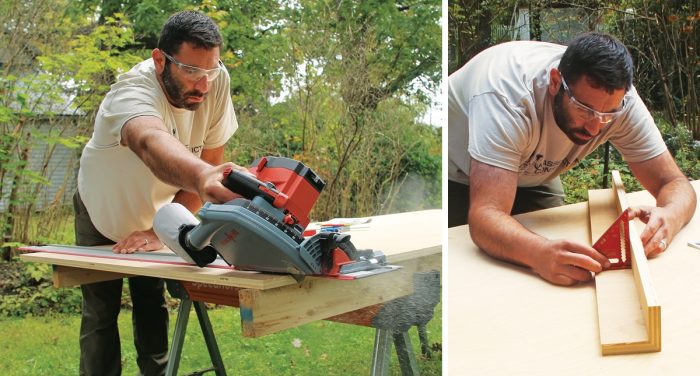
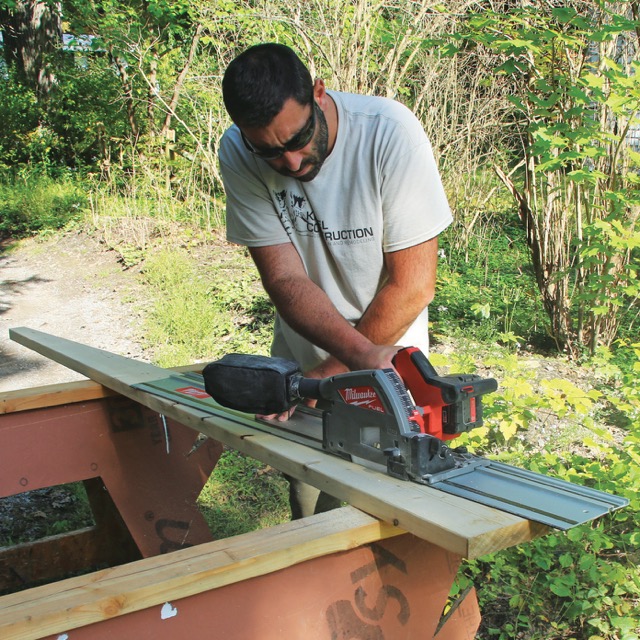 |
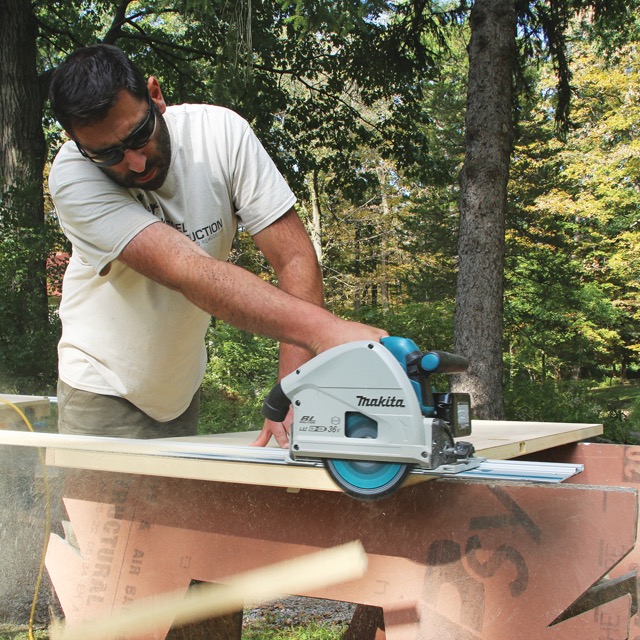 |
Note: The prices that follow are for a whole setup to make 4-ft. or 8-ft. cuts, including the saw, one or two batteries (depending on the kit), charger, and tracks.
Bosch GKT18V-20GC
The Bosch track saw is the only 5-1⁄2-in. saw in the test, and it shows—the smaller blade won’t cut all the way through 2x stock beyond a 25° bevel. I like the depth adjustment that has detents every 1⁄16 in. and the scale that shows millimeters and inches. I’m also a fan of the 1° bevel scale and its precise adjustment. A digital display shows battery life and blade speed from 2800 to 5000 rpms; it also indicates when the saw has entered “eco” mode to extend runtime or when there’s danger of overheating.
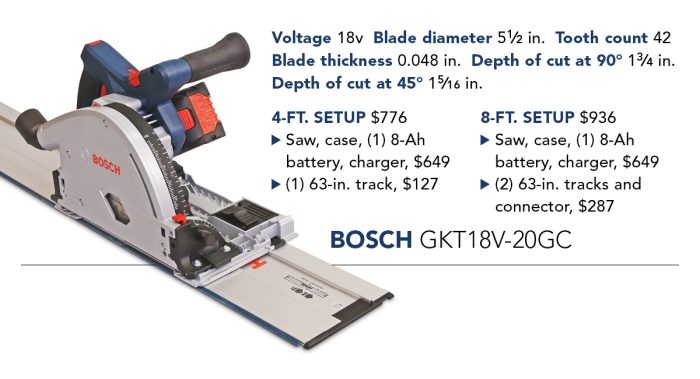
Precise controls on the saw’s base determine how tight it sits on the track. Like the Mafell, the Bosch track has a narrow profile that fits nicely on smaller cutting stock. The auxiliary handle on the left side is wide and prominent, making two-handed cutting strong and comfortable. The motor has less power and more vibration than I would have expected given the price. Cuts were somewhat splintery but accurate, producing a precise-fitting miter-fold in 3⁄4-in. plywood. It’s a good saw, but its small blade is a downside.
Mafell MT55 18m bl
Mafell uses the multi-manufacturer CAS battery platform that works with several European tool brands. The platform is more common in Europe but is making its way to North America. The Mafell uses a slimmer track profile, also found with the Bosch, that fits well on smaller stock. The saw also has an effective splinter guard on the offcut side and anti-slip pads for keeping the track on the work. Compared to other saws in the test, the Mafell showed less power when performing all of the cutting tasks, and the miter fold showed a gap despite good cut quality.
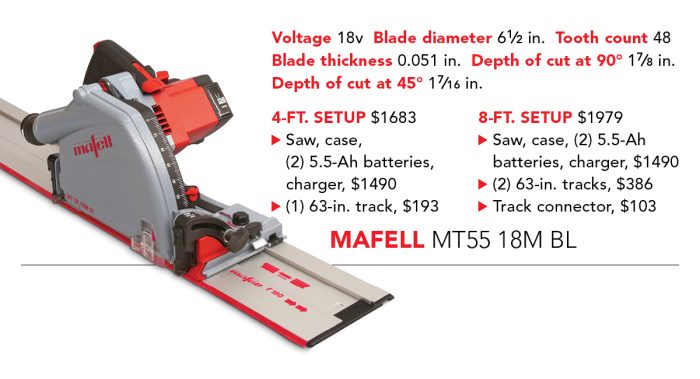
The bevel stop is adjustable, but I was surprised that the saw wasn’t dialed in better from the factory. However, the dust collection, even without a vac, is phenomenal, made possible by a fully enclosed blade guard and a large intelligently designed dust bag. Overall, the Mafell track saw has smart design with nice features, but I expected to be “wowed” by the saw and I just wasn’t. I would find it difficult to justify the price tag, which is double some of the other pro-level saws in the test.
Festool TSC 55 KeB-F (Best Overall)
Festool’s cordless track saw will run on a single 18v battery, but takes two for longer run times. I like the cutting depth adjustment with detents in 1⁄32-in. increments, which are helpful for making grooves and other non-through-cuts. The depth scale is in inches, but the saw includes an optional adhesive metric scale. The track has reliable high-friction strips and a semi-transparent splinter guard that allows you to see pencil marks that would otherwise be covered.
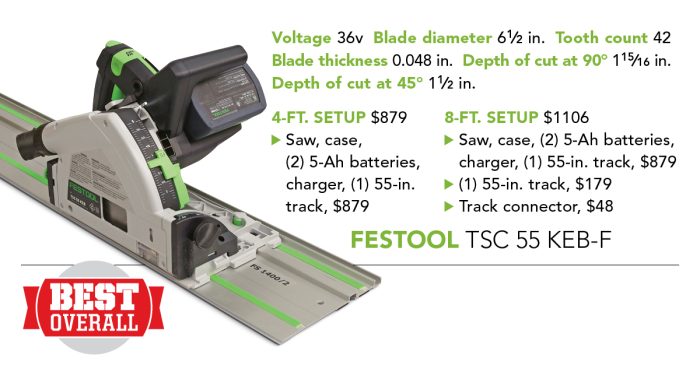
Ripping a 45° bevel on 3⁄4-in. birch plywood was easy and produced an accurate miter-fold. Adjusting the saw is intuitive and dust management is good. The only aspect that I don’t like is the handles—the main handle cramped my knuckles against the blade housing and I couldn’t comfortably tuck my left thumb under the front handle. That said, the Festool is the most powerful, smoothest tool in the test and is a pleasure to use.
Makita GPS01 (Best Value)
The Makita 40v track saw powers through hard cutting tasks and feels great in the process. The saw is super-precise and tight to the track, yet still glides smoothly and has comfortable, roomy handles. Like a few of its competitors, the Makita 40v has an anti-tip feature that locks the saw to the track to keep it in the track when beveling. There’s also Bluetooth capability, which is useful for automatically starting and stopping Bluetooth-enabled dust extractors when the saw’s motor is running.
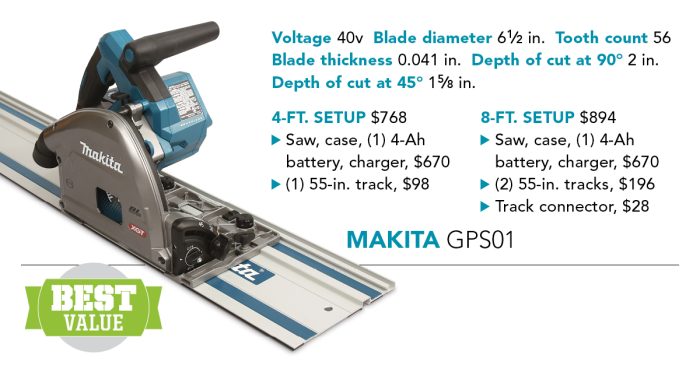
My only complaints are the blade depth adjustment, which is not auto-locking or indexed, and the depth scale, which I wish included fractions of an inch in addition to the metric scale. The miter-fold test had very good cut quality with the included blade. I’d love if it came with a dust bag, but the swiveling dust port is nice when using a dust extractor or vacuum. The 40v Makita saw is a top-notch track saw with smooth operation and excellent ergonomics at a reasonable price.
Makita XPS01 (Best Value)
I’ve owned a Makita 36v track saw for two years along with 55-in. and 118-in. Makita tracks. One of the reasons I chose it was my collection of 18v Makita batteries. It’s been a great saw—its cutting accuracy is extremely similar to its 40v cousin, and the saw has nearly all of the same features. Besides needing a pair of 18v batteries instead of one 40v pack, the primary difference between the two models is that the 36v Makita is not Bluetooth capable, so you’ll need to manually start an extractor for dust collection.
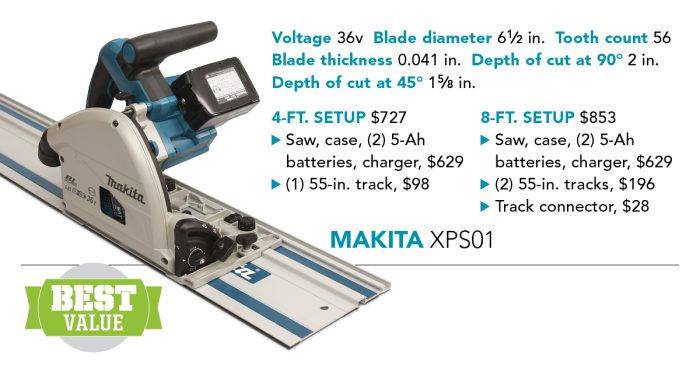
This saw performed very well during testing, revealing great cut quality; a tight, square miter-fold; and power on par with— if not better than—the more expensive saws. Needing a pair of batteries might be a downside to some, but the 36v Makita is only slightly less powerful than the 40v version. I consider both of them best-value tools; if you’re already using tools from the 18v Makita battery platform, this one’s a no-brainer.
Ridgid R48630
I like Ridgid’s depth-of-cut adjustment that includes scales for using the saw on and off the track and reads in fractions of an inch. All of the scales and adjustments are easy to read and adjust even with gloved hands. The two-piece track is easy to assemble and cuts straight. Its accuracy provided a good fit for the miter fold. Unfortunately, the low-friction tape on the face of the track that makes the saw easy to slide needs better adhesive from the factory. It started to peel off even before I ran the saw on the track for the first time.
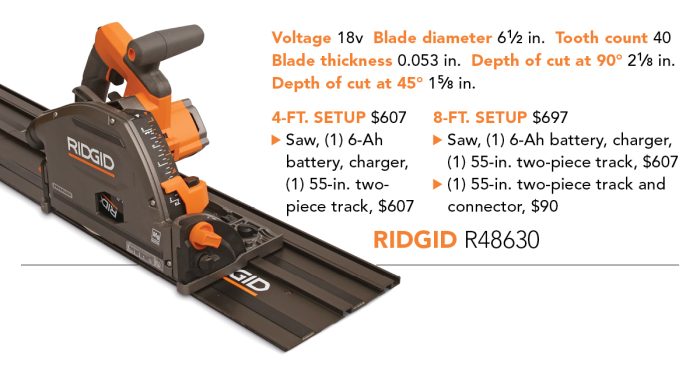
Thankfully this did not affect saw performance or cut accuracy. I did notice the saw had noticeably less power than other saws when I was cutting the 3⁄4-in. birch plywood on a 45° bevel and making tapered rips through 2x8s. On the plus side, the miter-fold test showed smooth, accurate cuts right out of the box. Other nice features include a swiveling dust port, an auto-locking depth adjustment, an anti-tip system, a riving knife, and a blade that produces nice finished cuts. Despite these features and its low price, the saw’s lack of power makes it less appealing.
Milwaukee 2831-20
The Milwaukee track saw has some great features. I love its blade-depth adjustment with its fractional scale and stops in 1⁄16-in. increments. I also like the blade-depth indicator, which has two marks—one for when you’re using a track, and one for freehand cutting without a track. Another smart feature is the little piece of plastic that snaps into the saw’s housing and works as a splinter guard for the “offcut” side of the blade.
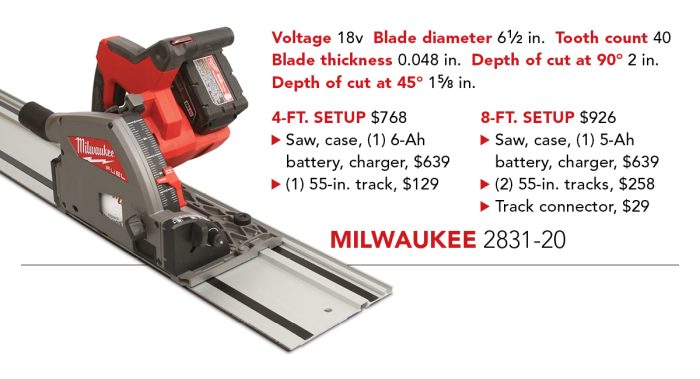
I found the adjustment for dialing in how the saw fits to the track had a very fine line between too tight, where the saw wouldn’t slide easily, and too loose, where the saw wobbled and created a slightly curved cut. The Milwaukee has good dust collection with the included dust bag, but it doesn’t have stellar cut quality with the supplied blade. However, it did a reasonable job with the miter-fold test, creating a square assembly with no visible gap at the seam between panels. The anti-tip feature is similar to the arrangement on the Makita saws, but it’s more difficult to engage due to its small knob.
Ryobi PTS01
Ryobi’s track is a heavy, two-piece arrangement that I couldn’t make as straight as Ridgid’s two-piece version. The splinter guard also came unglued from the track when I was trimming it to establish the kerf line. The stiff dust port is not adjustable and shoots directly back to the user. The cams to adjust the glide of the saw in the track were very difficult to adjust and made it tough to nest the saw on the track. The blade-depth adjustment knob is clunky and difficult to twist, especially when it’s in the deepest position down against the base plate.
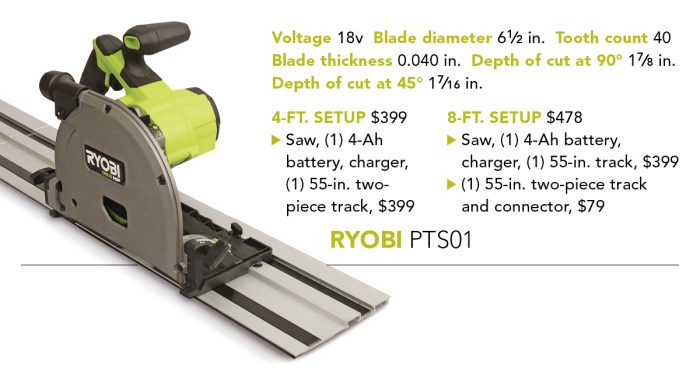
During testing, I quickly found the saw to be underpowered compared to the others, resulting in slower, rougher cuts. However, one feature that I really like about the Ryobi is the labels molded into the base that describe what the knobs are for. Another slick feature is the lever that locks the blade depth. You can lock the blade in the correct position to change the blade, make normal plunge cuts, or make scoring cuts on splintery materials. I also like the fractional depth scale.
— Jeremy Kassel; builder in Glenmont, N.Y. Photos by Patrick McCombe.
From Fine Homebuilding #323
Want More Tips and Tricks?
If you’re looking for more information on using a cordless track saw, be sure to check out Jeremy Kassel’s recent video series for Fine Homebuilding. This series includes tips on how to use this incredible tool as well as how to get the best results every single time.
RELATED STORIES





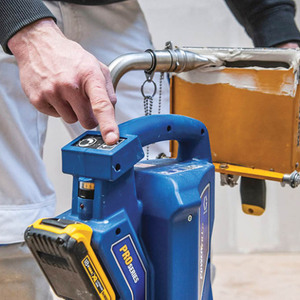



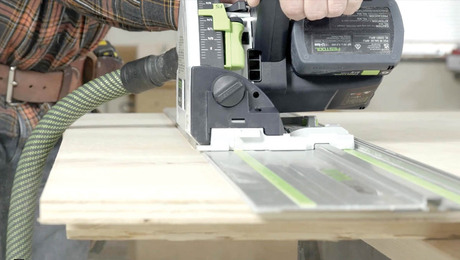
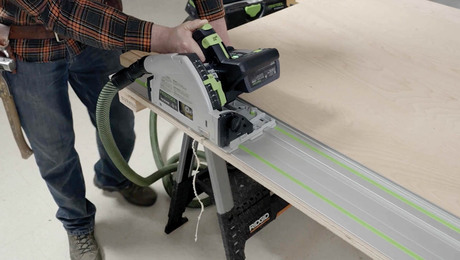


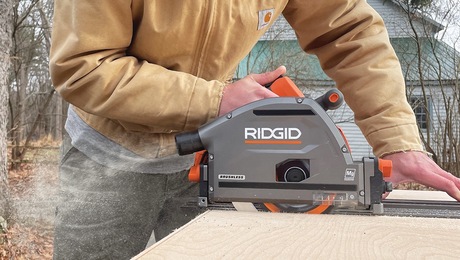
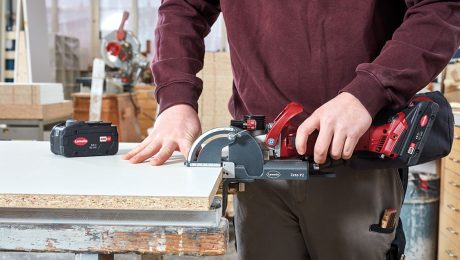
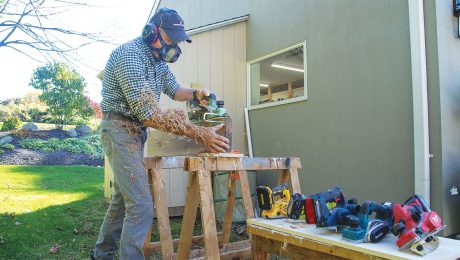










View Comments
I am surprised to see that you did not include a Dewalt cordless track saw in your comparison but yet you have 2 Makitas in the test. I would say that Dewalt is a very common/popular brand and would have loved to see it in comparison to all the others you have tested. That would be more useful that showing us a saw that uses a European platform. Other than that this looks to be a decent test and write up about the saws that were a part of it.
Incomplete review without testing the DeWalt Flexvolt tracksaw.